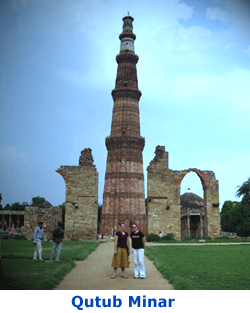|
The world famous towering Qutub Minar, started in 1192 by Qutub-ud-din Aibak (1192-98), breathes down the neck of the Quwwat-ul-Islam mosque. There is a slight difference of opinion as to its purpose: it probably was a tower of victory, but then again it could have been built to be a minar (tower), attached to the Quwwat-ul-Islam mosque, for the muezzin (priest) to climb up top for a prayer. The Major Gateways Considering how shortchanged he was for time, it is doubtful that Qutub-ud-din got much further than a couple of levels of the minar, in fact many suggest that lived to see only the first storey complete. Altamash, his successor, completed the remaining tower. It is clear that the tower was very close to the sultanate's heart, since repeated efforts were made to keep it in perfect shape. In its long career, the tower got hit by lightening twice – something that, of course, with its height it was literally asking for. Once during the reign of Muhammad-bin-Tughlaq, who very decently repaired the ensuing damage. The next time was in the indefatigable builder Feroze Shah Tughlaq's time, when the topmost storey got damaged. Feroze Shah, who of course couldn't well leave things alone, not only repaired the floor, but also sneaked in another level. The result of this combined effort is an interesting mix in styles that is clearly discernable all over the tower. Each of the original three storeys has different designs. The base storey has alternate angular and circular flutings while those of the second one are round and the third one has only angular flutings. Their alignment is mercifully similar, so giving the tower a rhythmic harmony. The pretty projecting balconies have a very interesting pattern, with icicle-shaped pendentive (an intricate design in which triangular pieces of vaulting spring from the corners of a rectangular area and support a rounded or polygonal dome) type of brackets. The attractiveness of the balconies is heightened by the bands of sonorous inscriptions. The diameter (at base) of the Qutub Minar is 14.32m and about 2.75m at the top. The tower had a crowning cupola on the top at one time, however this was struck down sometime in the early 19th century, an earthquake felled it. This was replced by a well meaning English engineer Major Smith. However it must have looked quite an eyesore for when Lord Hardinge was Governor-general of British India, he had it removed. You can see it now on the spruce lawns of the Qutub complex. Come to think of it, it must have been eyesore – it's called Smith’s folly. |
|||||||
|
|
|||||||




